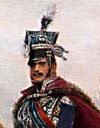Almost all commentators agree that this operational plan constitutes one of Napoleon's masterpieces. He intended to create a formidable battalion carre of almost 200,000 men and launch it across the Dnieper river on a 15-mile front in two large columns through Rosasna and Orsha with the greatest possible secrecy, intending to turn the Russian left while his opponents amused themselves cautiously probing toward Vitebsk on the opposite bank of the river. The Rosasna column, under the Emperor's personal command, was to consist of Murat's cavalry, the IIIrd Corps d'Armee, the Imperial Guard, and the Viceroy of Italy's contingents. Further south Marshal Davout was to cross with the Ist, Vth and VIIIth Corps, forming the second column, while Latour-Maubourg's Corps of Reserve Cavalry launched a diversionary attack still further down the Dnieper. Once safely over the river, the main attack would advance eastward along the left bank, aiming to sever the roads linking Smolensk with Moscow, force Barclay to fight, then drive the remnants of the Russian forces away to the north. This was a maneuver of strategic envelopment worthy of the one that preceded the great triumph of Jena-Auerstadt in 1806, and if it had fully succeeded the fruits of victory would have been no less impressive.
French Grand Armee columns on the march
~D. Chandler, The Campaigns of Napoleon, p. 783






















































No comments:
Post a Comment